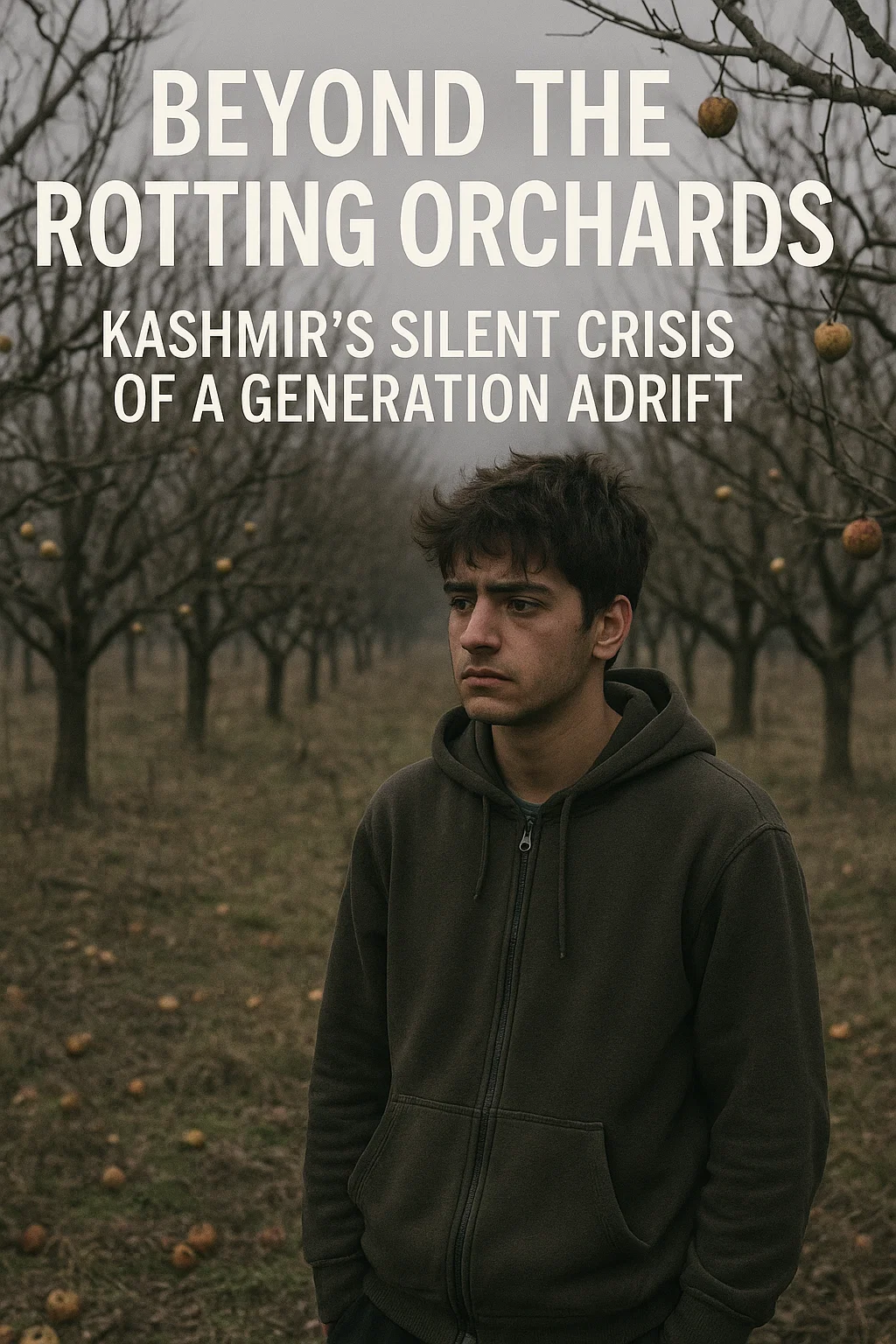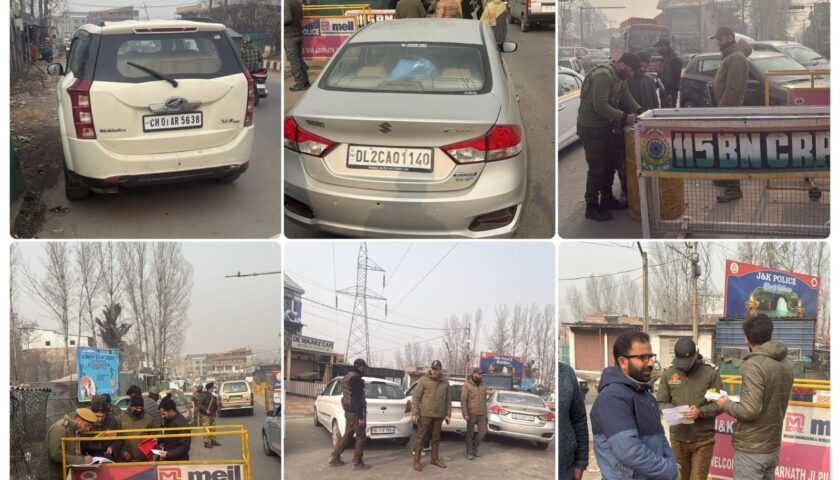Kashmir’s Dual Crisis: Apple Orchards Rotting & A Generation’s Values Eroding | Expert Analysis
By: Javid Amin | 17 September 2025
A Season of Ruin in the Valley of Plenty
The scent of decay hangs heavy in the crisp autumn air of Kashmir. It’s a poignant, sweet-sour smell that speaks of loss. In orchards that stretch across the valley floor and climb the gentle Himalayan slopes, a bounty is turning to mush. Piles of once-prime apples—the iconic Trew, American, and Maharaji varieties—lie discarded, their vibrant reds and greens fading into a uniform, melancholic brown. This is the most visible face of Kashmir’s current anguish: an economic catastrophe of staggering proportions.
The numbers are numbing. Estimates suggest losses running into thousands of crores of rupees. Mandis, the bustling, vibrant economic hearts of towns like Shopian and Sopore, wear a deserted look. The constant hum of trucks ferrying produce to markets across India has fallen silent. For the apple grower, the baghwan, this isn’t just a bad season; it’s the unraveling of a lifetime of toil. The orchard is more than a source of income; it is his legacy, his bank, and his identity. To see it rot on the branches is a profound personal and financial wound.
Yet, as haunting as this visible decay is, it is merely the symptom of a far deeper, more insidious malady. The real crisis in Kashmir is not just rotting in the orchards; it is festering in homes, in classrooms, and in the very psyche of a generation. It is the silent, unchecked erosion of purpose, prayer, and principle. While the economy can, with intervention, roads, and policy, potentially recover, who will rebuild the conscience of a generation? This is Kashmir’s existential question, and it demands our urgent attention.
The Tangible Crisis – An Economy Built on Apples Crumbles
The Apple of Kashmir’s Eye: Understanding the Industry’s Backbone
To comprehend the magnitude of the loss, one must first understand the centrality of the apple industry to Kashmir. It is not merely a crop; it is the bedrock of the rural economy. The sector contributes a staggering over 8% to Jammu & Kashmir’s Gross State Domestic Product (GSDP) and engages directly or indirectly with over 3.3 million people—that’s nearly every other family in the valley.
The lifecycle of the apple is the rhythm of Kashmiri life. The year begins with the delicate budding in spring, turning the valley into a breathtaking canvas of pink and white blossoms. This is followed by the meticulous care of summer—pruning, thinning, and protecting the young fruit. Autumn is the grand finale: the harvest. It is a time of immense activity, familial collaboration, and hopeful calculation. The sale of the harvest determines the year’s fortune—paying for weddings, education, new homes, and investments for the next season.
The supply chain is a complex web. The baghwan (grower) sells to a commission agent in the mandi, who then sells to wholesalers across India. From there, the apples travel to local vendors, eventually reaching the consumer. This entire ecosystem is now in peril. When the mandis shut down, the shockwave doesn’t just stop at the farmer; it devastates the transporters, the packers, the cold storage owners, the commission agents, and the daily wage laborers whose families depend on this seasonal work.
The Perfect Storm: Causes of the Economic Collapse
The current crisis is not a single-event disaster but a “perfect storm” of interconnected factors:
-
Supply Chain & Logistics Disruptions: Inconsistent transportation facilities, highway closures, and the soaring cost of diesel have made the physical movement of produce fraught with uncertainty and exorbitant expense. The uncertainty makes traders hesitant, leaving farmers stranded with their perishable cargo.
-
Market Volatility & Policy Shifts: The influx of cheaper, imported apples, particularly from Iran and Afghanistan, and a shift in procurement policies have disrupted traditional market dynamics. Kashmiri apples, often superior in quality, are struggling to compete on price, leaving farmers with a terrible choice: sell at a significant loss or don’t sell at all.
-
Climate Change Anxieties: Erratic weather patterns—untimely rains, hailstorms, and warmer winters—are increasingly damaging crops. This adds a layer of existential anxiety for the farmer, who now battles not just market forces but also the unpredictability of nature.
The consequence is a pervasive sense of despair. The baghwan who was once a proud, self-reliant pillar of his community now feels vulnerable and abandoned. This economic precarity is the fertile ground in which the seeds of a much deeper social crisis are sprouting.
The Intangible Catastrophe – The Rot Within
From Orchards to Screens: The Great Displacement
As the traditional economic structures wobble, a fundamental displacement is occurring. The previous generations found their identity, discipline, and purpose tied to the land. The rhythm of nature instilled patience, the harvest taught the value of hard work, and the interdependence of the community fostered empathy and collective responsibility.
Today, that connection is severed. The youth, seeing the struggle of their parents, are increasingly disillusioned with agrarian life. They are not heading to the orchards; they are retreating into a different world—a digital one. The smartphone has become the new field, the new classroom, the new meeting place, and for many, the new escape.
Smartphones in every hand, but no wisdom in sight. This is not an indictment of technology itself, but of its unchallenged and all-consuming dominance. The device is a gateway to infinite information, but in the absence of guidance and critical thinking, it becomes a vortex of distraction, misinformation, and shallow validation.
The Algorithmic Alteration of Identity
Kashmiri culture, with its rich tapestry of Sufi traditions, poetry, craftsmanship, and community ethics, is being quietly overwritten by a global, algorithm-driven culture.
-
Reels over Reality: Platforms like Instagram Reels and TikTok offer a curated, sensationalized version of life. The slow, meaningful progress of nurturing an apple tree cannot compete with the instantaneous dopamine hit of a viral video. Reality seems dull in comparison to the glittering, hyper-stimulating digital world. The value of patience, a cornerstone of agrarian life, is being erased.
-
Validation over Values: Self-worth is becoming increasingly externalized, measured in likes, shares, and follower counts. This creates a generation hungry for attention but starved of genuine connection. The internal moral compass, once calibrated by family, community, and faith, is being recalibrated by the metrics of social media popularity.
-
The Digital Void and the Rise of New Escape Hatches: Boredom, as the Shopian teacher astutely noted, has become the new fear. The constant stimulation of the digital world has eroded the capacity for stillness, for introspection, for simply being. To fill this void, many are turning to far more dangerous escapes.
-
Drug Abuse: Kashmir is grappling with a terrifying surge in substance abuse among its youth. From prescription pharmaceuticals to hard drugs, addiction is rampant, tearing families apart and destroying young lives. It is a silent epidemic, a desperate attempt to numb the pain of purposelessness.
-
Aggression and Mental Fragility: Exposure to curated perfection online breeds insecurity and frustration. Unmoderated exposure to violent content desensitizes and agitates. This manifests as shortened tempers, a rise in aggression, and profound mental health issues like anxiety and depression, which remain heavily stigmatized and largely untreated.
-
The Quiet Erosion of the Kashmiri Social Fabric
The collateral damage of this shift is the disintegration of core social structures:
-
The Family Unit Under Strain: The dinner table conversation is replaced by silent scrolling. Parents, often digitally illiterate themselves, are unable to relate to or guide their children through this new landscape. A deep generational chasm has opened up, fueled by mutual misunderstanding.
-
The Classroom Dilemma: Teachers, like the one quoted in Shopian, are powerless. How does one compete with a pocket-sized universe of entertainment? Education, which should be about cultivating wisdom and critical thinking, is losing the battle for attention. Students are physically present but mentally absent, scrolling through violent or trivial content while a lesson on history or literature unfolds.
-
The Eclipse of Spiritual and Cultural Grounding: The time once spent listening to grandparents’ stories, participating in community festivals, or engaging in quiet prayer is now consumed by screen time. The spiritual solace and cultural grounding that have historically been Kashmir’s resilience anchor are weakening.
Weaving the Threads – Connecting the Economic to the Existential
It is crucial to understand that these two crises—the economic and the social—are not separate. They are deeply intertwined in a vicious cycle.
Economic Despair → Loss of Parental Authority & Hope → Youth Disillusionment → Digital/Drug Escape → Further Social Decay → Deepened Economic Vulnerability
The father, once a provider and role model, now feels like a failure. His authority diminishes. He cannot advise his son on a future he himself cannot navigate. The son, seeing no viable future in his father’s world, seeks solace elsewhere. This loss of hope is the bridge between the rotting apple and the rotting value.
“We used to fear bullets. Now we fear boredom.” This statement from the Shopian teacher is one of the most profound commentaries on modern Kashmir. It signifies a transition from a period of clear, external, physical threat to an era of ambiguous, internal, psychological warfare. The enemy is no longer always outside; it is within, in the form of emptiness, nihilism, and addiction. This boredom is not trivial; it is a vacuum of meaning, and nature abhors a vacuum. It will be filled, and too often, it is filled with poison.
Sowing Seeds of Hope – A Path Towards Rehabilitation
All is not lost. But addressing this dual crisis requires a multi-pronged, empathetic, and collective effort. Rebuilding Kashmir requires not just economic packages, but a Moral & Social Infrastructure Revival Plan.
01. Economic Rehabilitation with a Human Face
-
Beyond Short-Term Relief: Immediate financial aid is needed, but it must be coupled with long-term strategy. This includes investing in robust cold storage chains, modernizing packaging, creating direct-to-consumer market linkages, and providing genuine insurance safety nets for farmers.
-
Diversification and Youth Inclusion: Encourage and fund alternative and complementary high-value agriculture (saffron, walnuts, cherry cultivation, floriculture) and tech-based agro-industries. Create schemes that incentivize educated youth to enter the agro-economy with new ideas—e-commerce platforms for Kashmiri produce, organic farming cooperatives, agro-tourism—making it aspirational again.
02. The Great Digital Literacy Campaign
-
Educating the Educators: Massive digital literacy programs are needed not just for students, but crucially, for parents and teachers. They must be equipped to understand the digital world, its perils, and its potentials, to regain their role as guides.
-
Critical Thinking Curriculum: Integrate digital citizenship and critical thinking into school curricula. Teach children how to discern fact from fiction, how algorithms work, and how to protect their mental health online.
-
Promoting Local, Positive Digital Content: Support creators who are making content in Kashmiri languages that celebrate local culture, history, science, and positive storytelling. Flood the algorithms with content that builds, rather than destroys.
03. Rebuilding the Community Core
-
De-stigmatizing Mental Health: Launch public health campaigns to normalize conversations around mental health. Integrate counseling services in schools, colleges, and communities. Train local religious and community leaders to identify and support those struggling.
-
Reviving Cultural Spaces: Create vibrant, attractive community centers—libraries, sports complexes, art studios, tech hubs—that offer healthy, engaging alternatives to screen time and idle loitering. Revive traditional storytelling, music, and craft sessions.
-
Inter-Generational Dialogue: Facilitate structured platforms where elders and the youth can communicate, share stories, and rebuild bridges of understanding. The wisdom of the past must meet the energy of the future.
Bottom-Line: The Choice Before the Crossroads
Kashmir stands at a critical crossroads. One path leads to a deeper descent into despair, where the economic ruin of today gives way to the moral bankruptcy of tomorrow. The other path, though arduous, leads toward renewal.
The rotting apples are a tragic warning, a visible symbol we cannot ignore. But the rotting values are the real battlefront. This is not a fight that can be won by the government alone, or by parents alone, or by teachers alone. It requires a collective awakening—a community-wide jihad against ignorance, despair, and addiction.
The future of Kashmir will not be decided solely in the orchards or the mandis. It will be decided in the living rooms, where a parent chooses to put down their phone and listen to their child. It will be decided in the classrooms, where a teacher finds a way to make literature more compelling than a reel. It will be decided in the community spaces, where a young person chooses a book, a football, or a conversation over a needle or a pill.
The algorithms are powerful, but the human spirit, especially one as resilient as Kashmir’s, is more so. It is time to log off from the distraction and tune back into reality. It is time to harvest not just apples, but hope. The season of ruin can be followed by a season of sowing. And from that sowing, a new, conscious, and connected generation can rise.




